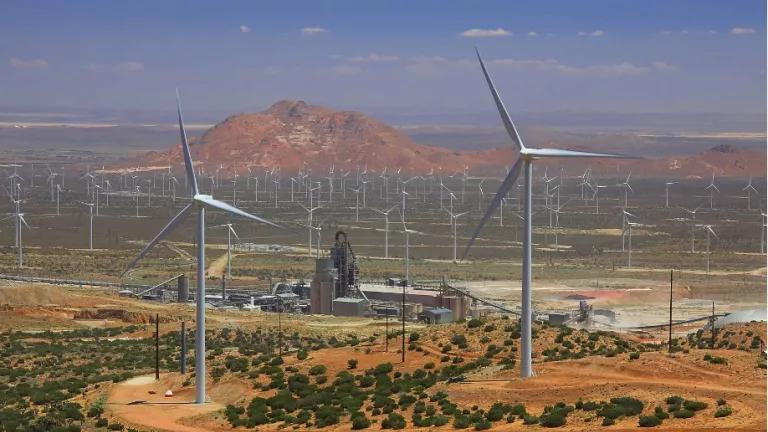California Companies Secure $700 Million for Cement Decarbonization
The Department of Energy recently announced that 33 industrial projects, including two California-based companies, will receive federal funding to decarbonize.

The National Cement plant in Lebec, CA.
Lauren Kubiak
The federal government announced the most significant investment in curbing greenhouse gas emissions from heavy industry last month. The U.S. Department of Energy’s (DOE) Office of Clean Energy Demonstrations (OCED) will give 33 projects up to $6 billion to demonstrate technologies that decarbonize the production of steel, cement, aluminum, and other materials with carbon-intensive production processes.
Two innovative California-based cement companies were central to the announcement, securing award negotiations for nearly $700 million in funding to demonstrate decarbonized cement production processes. Successful adoption of such technologies will be crucial to meeting California’s zero-emission cement law, SB 596, which requires all cement used in the state to be net-zero emission by 2045.
Cement, the binder in concrete, is crucial to nearly all our infrastructure, but responsible for about 8 percent of global carbon emissions. Its emissions come from its super-high heat requirements that are met via fossil fuel combustion, as well as the chemical reaction where limestone (CaCO3) decomposes into CO2 and lime (CaO), the key component of cement. While the combustion emissions are difficult enough to address, the chemical decomposition emissions, or process emissions, are responsible for more than half of cement’s emissions and must be addressed either through carbon capture, or a different cement production process. Neither method has been demonstrated at full commercial scale, which is where OCED demonstration money comes in.
Novel cement production processes: $189 million for Brimstone’s technology
Brimstone was selected for negotiation for an up to $189 million award to build a commercial-scale facility that will demonstrate the start-up’s novel technology at scale for the very first time. Brimstone has developed a new cement production process that uses a different source rock to produce the same ordinary Portland cement that has been used for the past 200 years. Instead of limestone, CaCO3, Brimstone’s process uses calcium silicate rocks like basalt. Brimstone turns the calcium silicates into CaO to produce the same product as conventional cement plants, but without CO2 process emissions inherent in incumbent cement production processes.
Brimstone is headquartered in Oakland, California. It has been producing its cement at a laboratory-scale and will construct its pilot plant next year. While a promising technology, making the jump from pilot to commercial scale is a difficult hurdle for any nascent company to overcome. The OCED award will fund up to half of Brimstone's commercial demonstration plant. Securing the rest of the funding needed, and enabling other low-carbon cement companies to scale-up, also depends on obtaining offtake agreements from the largest users of cement—namely government agencies. NRDC is currently co-sponsoring legislation pending in the California state legislature, SB 1073 by Senator Skinner, with Brimstone and other innovative low-emission cement and concrete companies. This bill would enable California state agencies to purchase these ultra-low-emission cements in advance and thus unlock financing to commercialize and scale these new products.
Retrofitting existing cement plants: $500 million to retrofit National Cement’s facility
National Cement, which operates a cement plant in Lebec, California, was the other big California project highlight, securing an award negotiation of up to $500 million to decarbonize its existing plant. In operation since the 1960s, the plant has supplied southern California markets for decades and its owners have recently begun investing in technologies to reduce emissions. Their OCED application included a suite of emission-reduction technologies that address emissions at each step of the production process:
- Calcined clays: the first decarbonization lever that can be pulled to reduce emissions from incumbent cement production technologies is through clinker substitution. Clinker, the most carbon-intensive ingredient in cement, makes up around 95% of a final cement product by mass, and around 10% of the final concrete. Yet it is responsible for 90% of emissions from concrete. Other materials that aren’t so emissions-intensive to produce can be substituted to replace up to 40-50% of clinker, while increasing performance and durability of the final concrete product. One such material is known as limestone calcined clay, or LC3. National Cement proposes building an LC3 production facility onsite that they can blend with their cements or concretes to address 30-40% of emissions.
- Fuel switching: The second decarbonization lever National Cement proposed is substituting higher levels of biomass into their kiln. Cement kilns burn notoriously dirty fuels like coal, petroleum coke, and tires to generate the high temperatures required for cement production. National Cement’s kiln currently burns a mix of agricultural waste including pistachio shells, as well as tires, other types of waste like used carpet, and fossil fuels. Their OCED application proposes installation of a kiln technology that can burn higher levels of biomass. While certain types of biomass reduce emissions and air pollution, other types might emit pollutants or have land use impacts. It will be important for National Cement to focus on the types of biomass fuels with the lowest emissions, air pollution, and land use impacts like agricultural wastes in order to realize potential benefits of a biomass-fueled kiln.
- Carbon capture: The third and final decarbonization lever is post-combustion carbon capture and sequestration, or CCS. Cement’s process emissions cannot be eliminated simply by electrification alone and instead require either an innovative technology or carbon capture to abate. National Cement has proposed installing a post-combustion CCS system on their plant, which would be the first time such a CCS system is installed on a commercial cement production facility in the US.
As with all industrial decarbonization technologies, it’s important to ensure that community and local impacts are mitigated when building out this infrastructure. We look forward to working with National Cement and Brimstone to maximize emission reduction benefits and minimize any potential negative impacts.
Other nascent technologies
There are additional cement decarbonization technologies that are at earlier technology readiness levels but may emerge as viable emission reduction strategies in the coming years. Such technologies include kiln electrification and capture of only process emissions (as opposed to post-combustion CCS which captures both process and combustion emissions). While neither of these technologies were selected for OCED funding, it will be important to continue to invest in those technologies to ensure we have a full suite of cement decarbonization technologies ready for commercialization.
California policy climate
It’s no coincidence that these two cement companies are located in California. With the adoption of SB 596 (Becker) in 2021, California became the first state in the country to require all cement used in the state to be net-zero emission by 2045. The California Air Resources Board is currently developing a strategy to achieve that target, and it is clear that these OCED projects represent a giant step forward. If the state can achieve robust implementation of SB 596, California can play to its strengths as a climate leader and innovator, pushing the envelope on new technologies that will be crucial to meet our climate goals.



